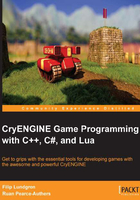
Compiling the CryGame project (C++)
The CryENGINE Free SDK ships with complete source access to the game logic library, CryGame.dll. This dynamic library is responsible for the main part of game features, as well as the initial game startup process.
To start off, open the main sample folder, and navigate to Code/Solutions/, in which a Visual Studio solution file named CE Game Programming Sample.sln should be present. Double-click on the file and Visual Studio should start up, displaying the included projects (see the following breakdown).
To build the project, simply press F7 or right-click on the CryGame project in the Solution Explorer and select Build.
What just happened?
You just compiled CryGame.dll, which should now be present in the binary folder. (Bin32 for 32-bit compilation, Bin64 for 64-bit). Launching the sample application will now load the .dll file containing the source code you compiled.
The CE Game Programming Sample solution breakdown
The solution includes the following three projects, one of which compiles to a .dll file.
The CryGame project includes the underlying game logic used by the engine. This compiles to CryGame.dll.
The CryAction project includes partial source to CryAction.dll, which is responsible for a large number of systems, such as actors, UI Graphs, and game objects. This project does not compile to a .dll file, but is instead only used for interface access.